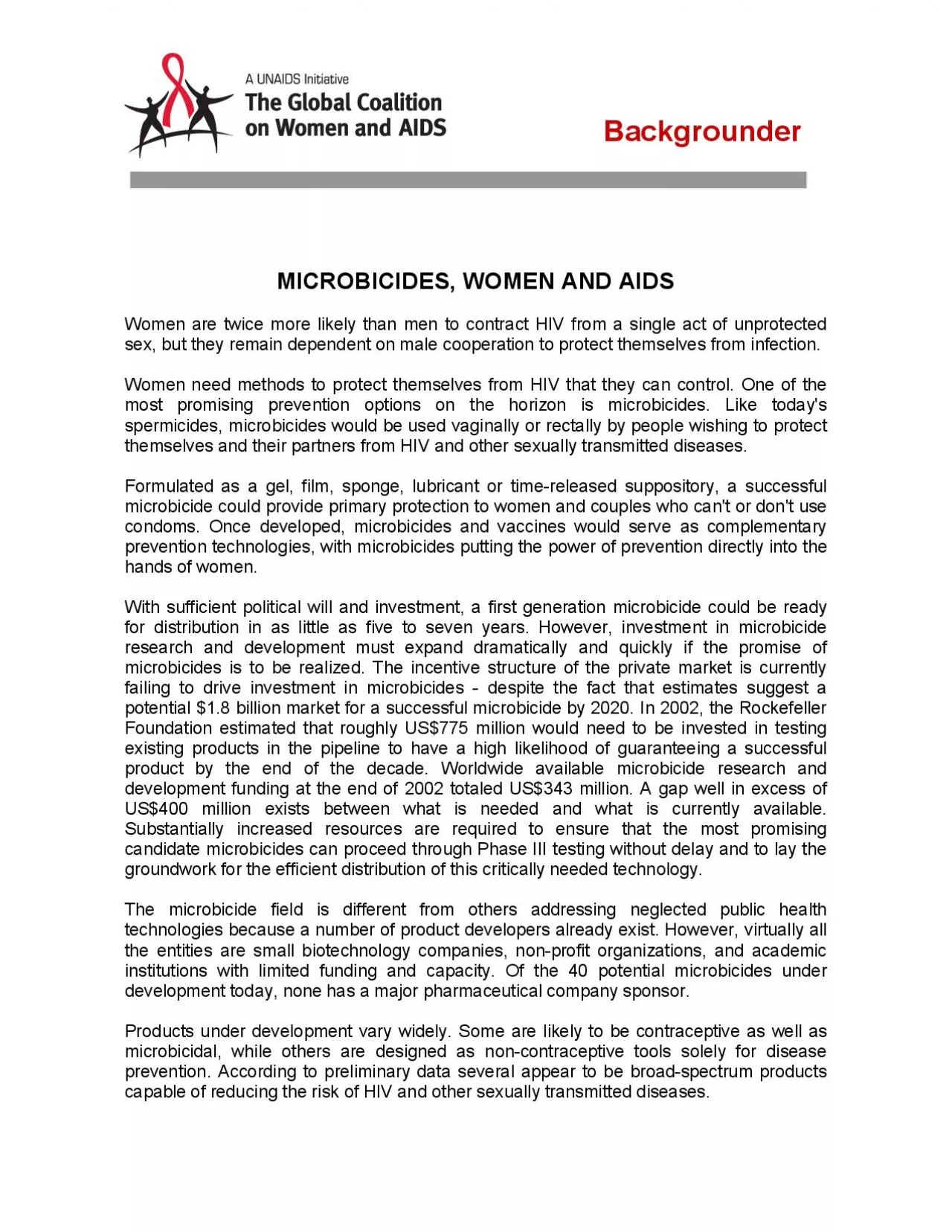

Women are twice more likely than men to contract HIV from a single act of unprotected sex but they remain dependent on male cooperation to protect themselves from infection Women need methods to pr ID: 945179
Download Pdf The PPT/PDF document "Backgrounder" is the property of its rightful owner. Permission is granted to download and print the materials on this web site for personal, non-commercial use only, and to display it on your personal computer provided you do not modify the materials and that you retain all copyright notices contained in the materials. By downloading content from our website, you accept the terms of this agreement.
Backgrounder Women are twice more likely than men to contract HIV from a single act of unprotected sex, but they remain dependent on male cooperation to protect themselves from infection. Women need methods to protect themselves from HIV that they can control. One of the most promising prevention options on the horizon is microbicides. Like today's spermicides, microbicides would be used vaginally or rectally by people wishing to protect themselves and their partners from HIV and other sexually transmitted diseases. Formulated as a gel, film, sponge, lubricant or time-released suppository, a successful microbicide could provide primary protection to women and couples who can't or don't use condoms. Once developed, microbicides and vaccines would serve as complementary prevention technologies, with microbicides putting the power of prevention directly into the hands of women. With sufficient political will and investment, a first generation microbicide could be ready for distribution in as little as five to seven years. However, investment in microbicide research and development must expand dramatically and quickly if the promise of microbicides is to be realized. The incentive structure of the private market is currently failing to drive investment in microbicides - despite the fact that estimates suggest a potential $1.8 billion market for a successful microbicide by 2020. In 2002, the Rockefeller Foundation estimated that roughly US$775 million would need to be invested in testing existing products in the pipeline to have a high likelihood of guaranteeing a successful product by the end of the decade. Worldwide available microbicide research and development funding at the end of 2002 totaled US$343 million. A gap well in excess of US$400 million exists between what is needed and what is currently available. Substantially increased resources are required to ensure that the most promising candidate microbicides can proceed through Phase III testing without delay and to lay the groundwork for the efficient distribution of this critically needed technology. The microbicide field is different from others addressing neglected public health technologies because a number of product developers already exist. However, virtually all the entities are small biotechnology companies, non-profit organizations, and academic institutions with limited funding and capacity. Of the 40 potential microbicides under development today, none has a major pharmaceutical company sponsor. Products under development vary widely. Some are likely to be contraceptive as well as microbicidal, while others are designed as non-contraceptive tools solely for di
sease prevention. According to preliminary data several appear to be broad-spectrum products capable of reducing the risk of HIV and other sexually transmitted diseases. For more information, please contact: Dominique De Santis, UNAIDS, mobile (+41 79) 254 6803 or Geneva (+41 22) 791 4509 or email womenandaids@unaids.org. For more information about UNAIDS, please visit our website, www.unaids.org. For information about the Global Campaign for Microbicides visit the website www.global-campaign.org and for information on the International Partnership for Microbicides visit the website www.ipm-microbicides.org To date, 11 have advanced into human safety trials and four of these are scheduled to enter large-scale Phase II/III trials in 2004 to measure their effectiveness. Since Phase III trials take at least two years for data collection and another two years for data analysis and registration, microbicide advocates cite five to seven years as the soonest a new product could become available. Even this timeline may not be met, however, without more funding to keep research moving. Using mathematical modeling, researchers at the London School for Hygiene and Tropical Medicine showed that even a 60% effective microbicide could have substantial impact on the epidemic if introduced into the worlds 73 lowest-income countries. If such a product were used by only 20% of those women already in contact with health services, 2.5 million new infections could be averted among women, men and children in three years. In May, 2003,the Global HIV Prevention Working Group called for US$3.8 billion in additional annual spending by 2005 for existing prevention programmes. Specifically, the Working Group (a 40-member, international panel of leading public health experts, clinicians, biomedical and behavioral researchers, and people affected by HIV/AIDS) recommended additional public sector spending of US$1 billion for microbicides. Realistically, this is the level of investment needed to hasten the advent of first-generation microbicides. These first products, the Rockefeller Foundation study predicted, will create enough of a market to attract private investment. Market forces will then drive the development and refinement of second- and third-generation microbicides, which are expected to have efficacy rates as high as 80-90%. UNAIDS is working with a number of microbicide-specific organizations and networks (including the International Partnership for Microbicides and the Global Campaign for Microbicides) to highlight the critical need for female-controlled prevention options and to prepare NGOs and advocates to be active partners in this endeavor.